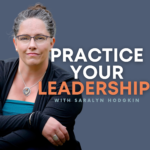Hey, everyone, I’m Saralyn Hodgkin. And this is the podcast to practice your leadership.
Hi all, Saralyn here. I was taking my dog for a walk, doesn’t that sound like the most normal thing in the world? Holy. But it was dark out and I was mad, so mad, I just closed that door to my house and I just went outside. The dusk was setting in, maybe the kids were still screaming in the house, I don’t even I didn’t even want to know, the things that were said and the arguments had and so on, it was just time for me to drop it and leave it and walk away. I don’t know if you’ve ever been in that place. But man, my stress was just at this height. And not just you know, within a piece of work or something, but with my family. And so the relational dynamics just takes it all over the edge.
And so I found myself without even thinking, without even thinking, walking in my good runners with a dog on a leash, my dog, and just walking and my my earbuds were in, there was some Beyonce cranking. I couldn’t hear anybody else. And I was walking so fast, mosquitoes couldn’t even keep up. And so I just kept going, I just kept walking. And I was not thinking. I didn’t rehash, I wasn’t problem solving. I wasn’t even, you know, having an argument with someone who wasn’t even there. I was just walking. And what I realized is that I was moving through, I was moving through.
And this comes to me from the idea of stress cycles. And I realized at some point, that I was in the middle of moving through a cycle of stress. And just because I had shut everybody out and said, If you all want to keep arguing back in the house, you go ahead. That’s how I dealt with that stressor, may not be one of my most shining moments. But walking out the door and not elevating it and shutting the door and taking the dog and walking. That was a good moment. But it doesn’t mean that I’ve dealt with the stress that was still sitting in that house. And I didn’t realize it at the time. But now when I think about it I can actually go back to that being of Saralyn, dog, dusk, Beyonce, walking.
I was starting to sweat and I don’t even know where I was going. I had no plan I just kept going. And I realized now that I was moving through a stress cycle that was honoring the cyclical nature of the emotions and moving through that and my antidote at the time without even thinking about it was walking the dog. And I didn’t realize I was through that stress cycle until I suddenly it was almost like I opened my eyes. And I see, Wow, I’m back at my driveway. How did that happen?
So the Nagoski sisters, Amelia and Emily Nagoski wrote a great book, I think like burnout, burnout, burnout, and the secrets to unlocking the stress cycle. And it really helped me realize that stress is a cycle. And one of the things that I took away from that book is that, you know, you can make the best laid plans for stressors that you may think, or come in, and you may be able to actually stand in abundant place to see the opportunities and what’s difficult. And you may even have the resiliency in the moment to redefine what winning means and what veiling means. But sometimes, stress just comes out of nowhere.
And so whether it comes out of nowhere, or whether you’ve made a plan for it, or whether you’ve made a plan for the stress that comes out of nowhere. What is the tendency it’s to, you know, stop, drop and roll, fight, flight or freeze. And sometimes you don’t get to choose if you’re going to fight or takeoff or freeze in the moment. But for me physiologically, in this moment, I knew that to get safely through the stress that was happening, I needed to fly, I needed to get out in through and I needed to honor that. And it wasn’t even a conversation in my head. But a lot of times it is. Sometimes I have to think about, Wow, I need to freeze, or I need to get out of here. Whatever it is, it’s a place where I am learning into trusting my body and what it tells me and in this moment when I suddenly realized I’m with the dog outside and walking. I’m like, wow, I trusted my body without even thinking there. The state of my emotions are in a place where I gotta go. I got to take flight.
But then what? You know, back in the day of whatever, way back when you know, the tiger chasing you, you went through running, all of our ancestors beat the tiger. At least that one good time, right? They beat that tiger and they got to safety. And your body moved through this physiological process that moved through a stress cycle and onto the other side of safety. But when you have a cash flow statement in front of you, when you have a theoretical stressor, when you’re trying to figure something out, our bodies aren’t yet made to figure out physiologically how to move through that stress cycle.
And so what do we need to do we need to move through the cycle. How do you then do that? Because if you freeze, or if you fly, or if you fight, that doesn’t necessarily mean that you’ve dealt with the stress of the stressor. And so what I took away as one of the main points from the Nagoski sisters’ book was, how do you use your body and breath to move through that stress cycle? Because just as they say, in the book, just because you dealt with the stressor doesn’t mean that you dealt with the stress, you have to move through it.
So does that mean go on for a walk? Does mean doing a two hour run? Does that mean sitting? And just doing some breathing? Does it mean that you’ve froze because sometimes for safety, you’re in a room and you’re like, Wow, look at this unsafe place that I find myself in, I need to just freeze, get past it. But then do you come back to that stressor? And that stress to be able to move through it? And how can you? How can you bring that, that bring that reality back to say, Yeah, I went through something that was quite stressful today. I froze in that moment in order to have safety and that is just fine.
Now I need to bring that stress back in order to move through it. Or else what does it do? What is the disease that it causes? How does it stick to you? How does it start to create ashphalt layers of armor on your being? On your joy? How can you move your body, your breath? How can you move through that stress cycle? Maybe it’s even for some maybe it’s journaling? Right? Maybe it’s writing. Whatever it is. One of the things that I learned when I reflected back on walking that dog, having my headphones on maybe a little too high, was moving through the stress cycle allows me to just leave it behind and that there is a natural cycle to it. If I can honor it. If I can bring it in and honor it. Stay in the practice.
Thanks all. I’m Saralyn. You can find me at holonleadership.org. I walk alongside you as you practice your leadership



 Apple Podcasts
Apple Podcasts Spotify
Spotify Google Podcasts
Google Podcasts